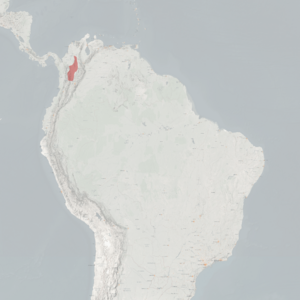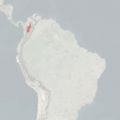White-footed tamarin facts for kids
Quick facts for kids White-footed tamarin |
|
|---|---|
 |
|
| Conservation status | |
| Scientific classification | |
| Genus: |
Saguinus
|
| Species: |
leucopus
|
 |
|
| Range of the White-footed Tamarin | |
The white-footed tamarin (Saguinus leucopus) is a small monkey that lives only in Colombia. It has silvery brown fur with lighter stripes and reddish-brown fur on its belly. This tamarin looks a lot like the cotton-top tamarin. The two species are mostly separated by the Atrato River. Scientists think they became different species a very long time ago, during the Ice Age, when a sea covered the area between them.
This tamarin lives in trees and stays in small family groups high up in the forest. Female tamarins usually have one to three babies after being pregnant for about 140 days. The white-footed tamarin lives in a fairly small area. Its home is shrinking because forests are being cut down. Because of this, the International Union for Conservation of Nature says it is a "vulnerable" species, meaning it is at risk of disappearing.
Contents
About the White-footed Tamarin
Many experts believe the white-footed tamarin (S. leucopus) is very closely related to the cotton-top tamarin (Saguinus oedipus). Studies have shown that they are very similar in many ways, including their teeth and how their fur changes as they grow up.
A scientist named Philip Hershkovitz suggested that these two species became different during the Ice Age. At that time, a sea covered the area where the Atrato River is now. This sea acted like a big wall, separating the tamarins and causing them to become two different species over time. Today, the Atrato River still mostly keeps them apart.
What They Look Like
The white-footed tamarin has a silvery pale brown back with lighter stripes. Its front side is a reddish-brown color. Its tail is brown, and sometimes it has a white tip. Its hands and feet are also white.
The tamarin's face has only a thin layer of white fur. It has thick brown hair around its neck and between its ears. Its front legs are shorter than its back legs. This animal can see, hear, and smell very well.
An adult male tamarin usually weighs about 494 grams (about 1.1 pounds). Adult females are only a little bit smaller, weighing around 490 grams. Unlike many other monkeys, tamarins have claws on all their fingers and toes, except for their big toe.
Behavior and Family Life
White-footed tamarins use special scents from their bodies to mark their home area. They live in groups with their extended family, usually with four to fifteen tamarins together. They live in trees and are active during the day.
These tamarins are very good at moving through the trees. They use all four of their limbs to help them climb and jump through the branches.
When it comes to having babies, one female tamarin might mate with more than one male. The female is pregnant for about 130 to 150 days. She usually gives birth to one to three babies. The male tamarins help raise the young and often carry them on their backs. Young tamarins become adults when they are about 12 to 18 months old. They have two main times of the year when babies are born: one between May and June, and another between October and November.
Where They Live and What They Eat
The white-footed tamarin lives in different kinds of forests, including tropical dry forests and tropical wet forests. They can be found in both old, untouched forests and newer forests that have grown back. They prefer to live near the edges of forests, especially close to streams.
Their diet includes insects, soft fruits, and nectar. They also eat sticky plant juices, small animals, and flowers.
Why They Need Our Help
The forests where white-footed tamarins live are disappearing quickly. People are cutting down trees for wood and digging up land for mining. Forests are also being cleared to make space for farms, roads, and dams.
Because of these changes, the number of tamarins is going down. Some tamarins are even caught and sold as pets in local markets. Due to all these problems, the International Union for Conservation of Nature has said that the white-footed tamarin is a "vulnerable" species. This means they are at risk of becoming endangered if we don't protect their homes.
Images for kids
See also
 In Spanish: Tití gris para niños
In Spanish: Tití gris para niños




